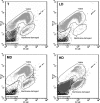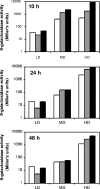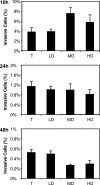Respective roles of culturable and viable-but-nonculturable cells in the heterogeneity of Salmonella enterica serovar typhimurium invasiveness
- PMID: 19525274
- PMCID: PMC2725472
- DOI: 10.1128/AEM.00334-09
Respective roles of culturable and viable-but-nonculturable cells in the heterogeneity of Salmonella enterica serovar typhimurium invasiveness
Abstract
The existence of Salmonella enterica serovar Typhimurium viable-but-nonculturable (VBNC) cells is a public health concern since they could constitute unrecognized sources of infection if they retain their pathogenicity. To date, many studies have addressed the ability of S. Typhimurium VBNC cells to remain infectious, but their conclusions are conflicting. An assumption could explain these conflicting results. It has been proposed that infectivity could be retained only temporarily after entry into the VBNC state and that most VBNC cells generated under intense stress could exceed the stage where they are still infectious. Using a Radioselectan density gradient centrifugation technique makes it possible to increase the VBNC-cell/culturable-cell ratio without increasing the exposure to stress and, consequently, to work with a larger proportion of newly VBNC cells. Here, we observed that (i) in the stationary phase, the S. Typhimurium population comprised three distinct subpopulations at 10, 24, or 48 h of culture; (ii) the VBNC cells were detected at 24 and 48 h; (iii) measurement of invasion gene (hilA, invF, and orgA) expression demonstrated that cells are highly heterogeneous within a culturable population; and (iv) invasion assays of HeLa cells showed that culturable cells from the different subpopulations do not display the same invasiveness. The results also suggest that newly formed VBNC cells are either weakly able or not able to successfully initiate epithelial cell invasion. Finally, we propose that at entry into the stationary phase, invasiveness may be one way for populations of S. Typhimurium to escape stochastic alteration leading to cell death.
Figures





Similar articles
-
RtsA and RtsB coordinately regulate expression of the invasion and flagellar genes in Salmonella enterica serovar Typhimurium.J Bacteriol. 2003 Sep;185(17):5096-108. doi: 10.1128/JB.185.17.5096-5108.2003. J Bacteriol. 2003. PMID: 12923082 Free PMC article.
-
Gamma radiation used as hygienization technique for foods does not induce viable but non-culturable state (VBNC) in Salmonella enterica subsp. enterica serovar Typhimurium.Curr Microbiol. 2009 Oct;59(4):420-4. doi: 10.1007/s00284-009-9454-3. Epub 2009 Jul 30. Curr Microbiol. 2009. PMID: 19641961
-
Viable-but-Nonculturable Listeria monocytogenes and Salmonella enterica Serovar Thompson Induced by Chlorine Stress Remain Infectious.mBio. 2018 Apr 17;9(2):e00540-18. doi: 10.1128/mBio.00540-18. mBio. 2018. PMID: 29666286 Free PMC article.
-
Control of virulence gene transcription by indirect readout in Vibrio cholerae and Salmonella enterica serovar Typhimurium.Environ Microbiol. 2017 Oct;19(10):3834-3845. doi: 10.1111/1462-2920.13838. Epub 2017 Jul 24. Environ Microbiol. 2017. PMID: 28631437 Free PMC article. Review.
-
Significance of Viable But Non-culturable (VBNC) State in Vibrios and Other Pathogenic Bacteria: Induction, Detection and the Role of Resuscitation Promoting Factors (Rpf).Curr Microbiol. 2024 Oct 21;81(12):417. doi: 10.1007/s00284-024-03947-8. Curr Microbiol. 2024. PMID: 39432128 Review.
Cited by
-
Contribution of Fluorescence Techniques in Determining the Efficiency of the Non-thermal Plasma Treatment.Front Microbiol. 2018 Sep 10;9:2171. doi: 10.3389/fmicb.2018.02171. eCollection 2018. Front Microbiol. 2018. PMID: 30250463 Free PMC article.
-
Intestinal Long-Chain Fatty Acids Act as a Direct Signal To Modulate Expression of the Salmonella Pathogenicity Island 1 Type III Secretion System.mBio. 2016 Feb 16;7(1):e02170-15. doi: 10.1128/mBio.02170-15. mBio. 2016. PMID: 26884427 Free PMC article.
-
Formation and resuscitation of viable but nonculturable Salmonella typhi.Biomed Res Int. 2013;2013:907170. doi: 10.1155/2013/907170. Epub 2012 Dec 26. Biomed Res Int. 2013. PMID: 23509799 Free PMC article.
-
Comparison of stress conditions to induce viable but non-cultivable state in Salmonella.Braz J Microbiol. 2020 Sep;51(3):1269-1277. doi: 10.1007/s42770-020-00261-w. Epub 2020 Apr 14. Braz J Microbiol. 2020. PMID: 32291740 Free PMC article.
-
Abundance and Distribution of Enteric Bacteria and Viruses in Coastal and Estuarine Sediments-a Review.Front Microbiol. 2016 Nov 1;7:1692. doi: 10.3389/fmicb.2016.01692. eCollection 2016. Front Microbiol. 2016. PMID: 27847499 Free PMC article. Review.
References
-
- Asakura, H., M. Watarai, T. Shirahata, and S. Makino. 2002. Viable but nonculturable Salmonella species recovery and systemic infection in morphine-treated mice. J. Infect. Dis. 186:1526-1529. - PubMed
-
- Bajaj, V., R. L. Lucas, C. Hwang, and C. A. Lee. 1996. Co-ordinate regulation of Salmonella typhimurium invasion genes by environmental and regulatory factors is mediated by control of hilA expression. Mol. Microbiol. 22:703-714. - PubMed
-
- Barer, M. R., and C. R. Harwood. 1999. Bacterial viability and culturability. Adv. Microb. Physiol. 41:93-137. - PubMed
-
- Caro, A., P. Got, and B. Baleux. 1999. Physiological changes of Salmonella typhimurium cells under osmotic and starvation conditions by image analysis. FEMS Microbiol. Lett. 179:265-273. - PubMed
Publication types
MeSH terms
Substances
LinkOut - more resources
Full Text Sources

